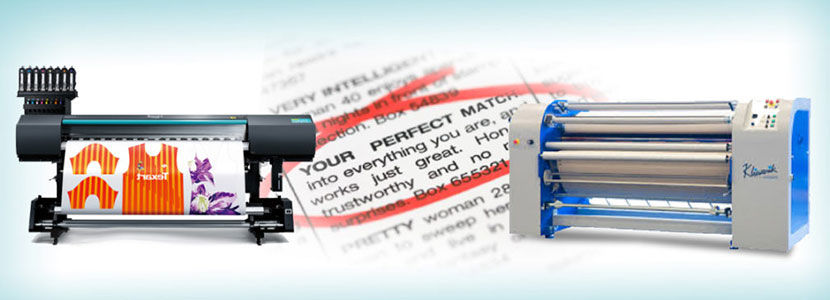La importancia de combinar la estampadora de termotransferencia correcta con su impresora de sublimación
Por Lily Hunter, Gerente de Productos para Tecnología de Sublimación de Roland DGA
Bueno, resulta que usted tiene en mente una impresora de sublimación, pero se pregunta qué tipo de estampadora completará su perfecto flujo de trabajo de sublimación. Hay muchas opciones en el mercado, y elegir la estampadora correcta no es fácil. Mucho depende del tipo de productos y aplicaciones que estén en su plan de negocios, y se tendrán que considerar otros factores como tamaño, tipo y costo.
Las estampadoras –también conocidas como prensas de calor– están diseñadas para aplicaciones específicas y vienen en todos los estilos y tamaños, y con precios muy diferentes: pueden costar desde US$ 1.000 hasta US$ 100.000. Los siguientes consejos describen algunos de los puntos más importantes a considerar al momento de comprar una estampadora para combinarla con su impresora de sublimación.
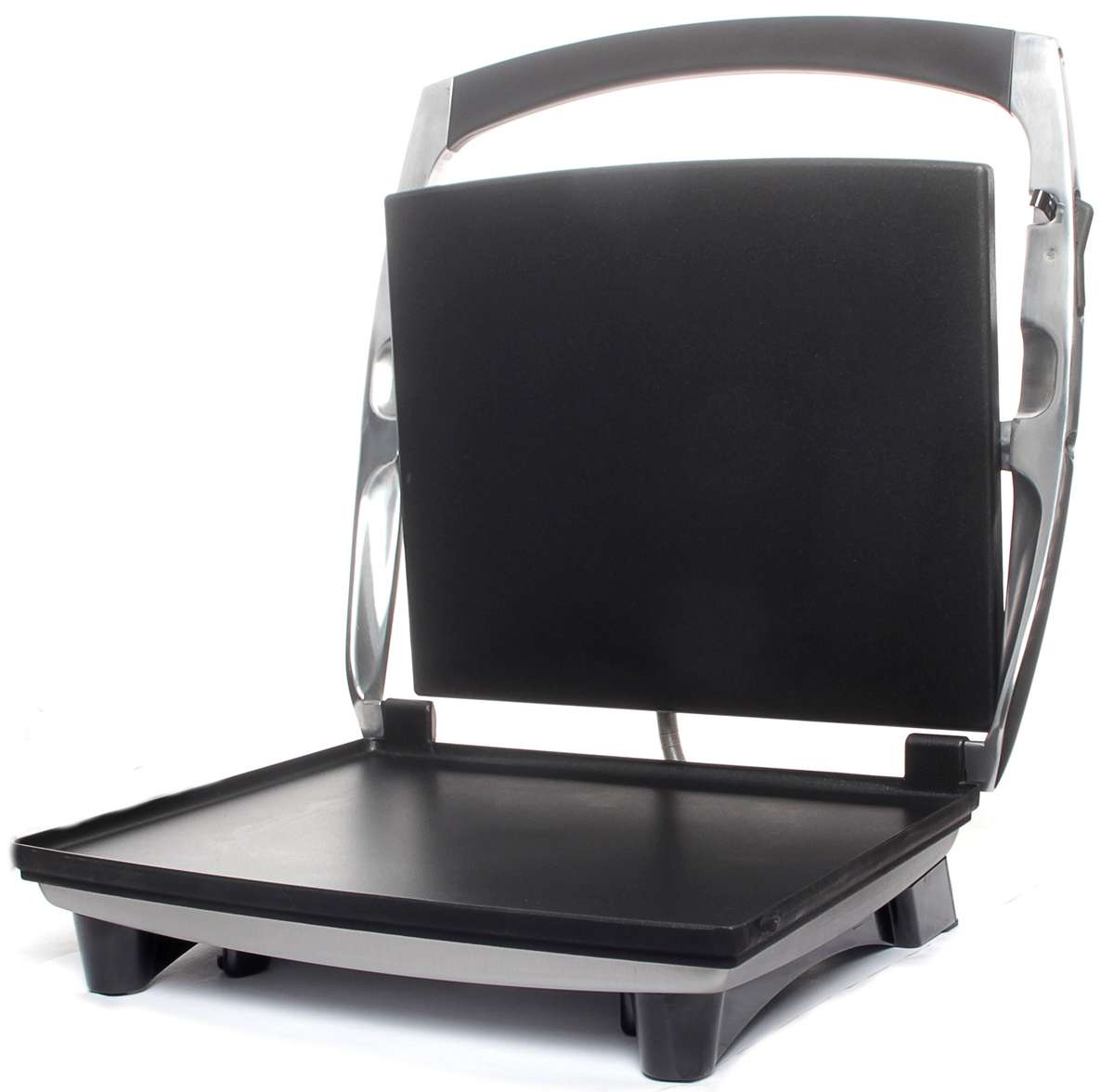
Usted tiene que estar dispuesto a invertir en una estampadora. ¡Si piensa en lo más barato puede terminar con una waflera gigante!
Invierta – A Largo Plazo
¿Por qué invertir en tecnología de impresión de sublimación de alta calidad como las XT-640 o RT-640 de Roland DG, productos de primer nivel, solo para comprometerse con una estampadora barata y terminar saboteando sus propios esfuerzos? Si usted basa su decisión solo en precios bajos, puede que termine arrepintiéndose a la larga. Cuando usted busca una estampadora de formato pequeño o grande, los modelos baratos simplemente no ofrecen la calidad de construcción o niveles de calor y presión constantes requeridos para producir resultados profesionales en termotransferencias.
Algunas de las estampadoras más baratas tipo almeja, abisagradas y de cama plana tienen bloques calentadores endebles, hechos de materiales que se calientan con rapidez pero se enfrían muy súbitamente, impidiendo mantener un calor parejo. Aunque una máquina con una placa pesada tarda más en calentarse, mantiene un calor estable y asegura que cada estampado tenga la misma consistencia y calidad de imagen y color. Al comparar físicamente las estampadoras, confíe en su instinto. Si una estampadora no se ve robusta y bien construida, lo más probable es que no lo sea ni funcione de forma correcta.
¿Qué Debe Tener la Estampadora Perfecta?
¿El tamaño importa?
En primer lugar, usted tendrá que pensar en cuál es su objetivo final: qué está produciendo y qué planea producir. Las estampadoras varían en tamaños de bloques calentadores, desde aproximadamente 15 cm x 20 cm para una estampadora de uso ligero, hasta los sobredimensionados de 110 cm x 162 cm y más. Ahora mismo usted probablemente esté considerando una estampadora de escritorio para personalización de ropa u otros productos, o una prensa de tamaño para taller que le permita diversificarse hacia la sublimación a mayor escala de textiles, letreros flexibles y otros productos grandes.

(Izquierda) la estampadora plana de formato grande de Geo-Knight – construida para la producción industrial de telas, decoraciones y letreros flexibles grandes, entre otros. (Derecha) La prensa tipo almeja Hotronix, disponible en modelos de escritorio y sobremesa, diseñada para producir una gama de productos pequeños y grandes de vestimentas, tales como camisetas.
Los tamaños de las estampadoras son muy variados. Como regla general, siempre es mejor pensar “a lo más grande” para darse la habilidad de expandir su gama de productos. Sin embargo, si usted quiere algo estrictamente para personalizaciones simples de camisetas y demás vestimentas, una estampadora grande de cama plana o de calandra puede a veces ser contraproducente, y usted descubrirá que una estampadora más pequeña abisagrada o tipo almeja para diferentes tamaños de vestimentas es en realidad más eficiente. Usted puede descubrir que un par de estas estampadoras más pequeñas, operadas por varias personas, pueden ser más efectivas para su modelo de producción que una sola máquina de formato grande.
Calor consistente
Las estampadoras necesitan ser calentadas hasta a 204°C para que las tintas de sublimación sean transferidas desde el papel a las fibras de polímeros. Esta transferencia debe ser delicada y pareja para un proceso correcto y para que la transferencia de imagen sea consistente de un estampado al otro. Algunas estampadoras pueden verse bastante avanzadas y elegantes, pero dentro de ellas la historia puede ser distinta.
Otro problema con las estampadoras baratas es la poca cantidad de calentadores de serpentín (devanados calentadores) en los bloques calentadores, o calentadores de serpentín demasiado separados entre ellos. Esto causa puntos fríos y una transferencia inconsistente. A más devanados calentadores tenga una estampadora, más rápido se calentará y recuperará el calor perdido entre trabajos.

Vista interna de cómo deben verse los calentadores de serpentín de un bloque calentador. Este ejemplo muestra la tecnología SuperCoil-Microwinding™ de doble devanado calentador de la marca Geo Knight.
Considerando que usted no puede ver los calentadores de serpentín en un bloque calentador, tendrá que hacer un esfuerzo y asegurarse de hacer las preguntas correctas a los distribuidores y fabricantes, preocupándose además en comparar estas características “no visibles” de las máquinas. También esté al tanto de las diferencias en potencia de los calentadores en serpentín, que también pueden afectar la consistencia del calor. A más potencia, mejor.
Presión consistente
Mantener una presión consistente durante el proceso de termotransferencia es extremadamente importante. Una estampadora de calidad tiene una placa pesada que genera una presión de carga suficiente para una termotransferencia limpia sin puntos fríos. Los modelos más baratos no tienen una placa lo suficientemente pesada y se les hace difícil mantener una consistencia de transferencia.
Pruebas de calor y presión con tiras de temperatura
De ser posible, recomendamos que pruebe su estampadora para una consistencia en calor y presión antes de comprarla. Incluso una estampadora de calidad puede tener placas deformadas, almohadillas de goma resquebrajadas, calentadores en serpentín ineficientes, u otros problemas que pueden causar puntos fríos. Usted puede comprar un kit de prueba de Stahls’ o de otros fabricantes de estampadoras para comprobar resultados en presión y temperatura. Estos kits contienen tiras de papel especiales que al ser colocadas en la estampadora, calentadas y presionadas, pueden detectar presión desigual y aplicación inapropiada del calor.
Manómetro
Para que la producción sea más sencilla y a la vez se asegure la uniformidad de la imagen, es también preferible elegir un modelo de estampadora con un manómetro incorporado. Los manómetros son extremadamente útiles para mostrar a los usuarios exactamente cuánta presión está siendo aplicada a cada estampado, con el fin de obtener mejores colores y consistencia de imagen en el producto final.

Ejemplo de un cronómetro y manómetro con una configuración “número 4” para mantener una consistencia en la presión a través de todos los estampados.
Temporizador
El tiempo es muy importante durante el proceso de termotransferencia. Si una estampadora es operada con un tiempo mayor que el recomendado de sublimación, las tintas seguirán evaporándose hasta desvanecerse. Por lo tanto, un mayor tiempo de estampado no necesariamente significa mejores imágenes, y cada tinta alcanzará una determinada intensidad máxima antes de empezar a desvanecerse. Los tiempos de estampado consistentes producen mejores resultados.
Tener un temporizador en su estampadora que mida el tiempo de cada estampado y alerte a los usuarios cuando sea completado es una función muy útil en modelos tanto análogos como digitales para garantizar una consistencia. Algunos de los modelos de estampadoras más recientes también tienen una función de abertura automática al final del ciclo temporizado, que levanta la placa cuando el proceso de estampado ha finalizado. Si usted tiene un taller muy activo, tener este tipo de funciones de estampado sin atender puede evitarle bastantes problemas.
¿Cuál es mi Tipo?
Al considerar una estampadora, existe un número de tipos distintos que funcionan con diversos tipos de materiales de impresión. Los siguientes dispositivos habilitan una transferencia efectiva sobre diferentes tipos y tamaños de sustrato:
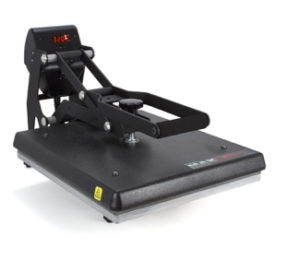
Estampadora tipo “Almeja”
La conveniente y compacta estampadora tipo “almeja” es la estampadora más común, y es usada para termotransferencias de vestimentas y artículos pequeños recubiertos como mosaicos y letreros de metal. También es usada para producir pruebas pequeñas de colores para telas antes de pasar a producir de lleno. Es una gran máquina para gente que busca personalizar camisetas, chaquetas y vestimentas simples. Es muy efectiva, pero limitada en sus posibilidades de producción de productos.
Estampadora tipo “almeja” Maxx.
Estampadora Abisagrada

Más avanzada tecnológicamente que la tipo “almeja”, la estampadora abisagrada está diseñada para trabajar con diferentes grosores de materiales. Tiene una configuración más avanzada, y una operación que siempre coloca la placa de forma plana sobre el material siendo impreso. La mayoría de estampadoras abisagradas trabajarán con materiales de al menos 2,5 cm de grosor, permitiendo a los usuarios estampar más artículos como placas y marcos de fotos. La acción giratoria de la máquina también previene quemaduras de nudillos y otros problemas relacionados con estampadoras tipo almeja.
Estampadora abisagrada Hotronix.
Estampadora de Calandra
A diferencia de las demás estampadoras mostradas en este artículo, las estampadoras de calandra no tienen bloques calentadores.. En su lugar, usan tambores calentados por aceite o electricidad para la termotransferencia desde un rollo impreso de papel a una tela de poliéster. El rollo de papel es adjunto a la prensa y alimentado junto con la tela.
 Las estampadoras de calandra de tamaño promedio están disponibles en anchos de trabajo de aproximadamente 165 cm a 180 cm. Algunas están diseñadas simplemente para rollos, y otras para permitir que piezas de telas pre-cortadas sean alimentadas de forma individual.
Las estampadoras de calandra de tamaño promedio están disponibles en anchos de trabajo de aproximadamente 165 cm a 180 cm. Algunas están diseñadas simplemente para rollos, y otras para permitir que piezas de telas pre-cortadas sean alimentadas de forma individual.
Estampadora de calandra de formato ancho a tambores de aceite Klieverik (arriba a la derecha). Estampadora Klieverik con mesa de alimentación (abajo a la izquierda), ideal para alimentar piezas individuales.
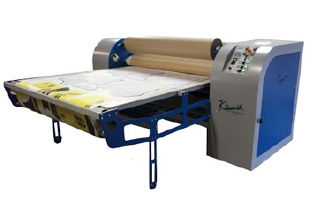
Las estampadoras de calandra son ideales para usuarios que deseen especializarse en vestimentas cortadas o confeccionadas, decoración, y letreros flexibles. Sin embargo, no pueden ser usadas para estampar sustratos rígidos. Los precios varían bastante, y dependen de si son a base de aceite o electricidad y del tamaño del tambor -a más grande el tambor, más cara la estampadora-; sin embargo, un tambor más grande significa mayores volúmenes y velocidades de producción. A diferencia de las estampadoras más pequeñas, las estampadoras de calandra requieren de un tomacorriente de 240 V con una configuración de dos polos y dos vías.
Las estampadoras de calandra están disponibles en los siguientes tipos:
Eléctrica
Esta es considerada una estampadora para principiantes que es más barata, pero aún así puede lograr resultados profesionales. A diferencia de la versión de tambor de aceite, lo que se calienta es el aire dentro del tambor eléctrico, permitiendo una mayor rapidez en calentado y enfriado. Esto es algo que puede ser una ventaja si usted está operando un negocio pequeño pero eficiente de sublimación.
De Tambor de Aceite
Asociada con la producción profesional de sublimación, la versión de tambor de aceite es una estampadora de calandra más cara, necesitando un compresor de aire para su funcionamiento. Disponible en modelos de producción media a alta, varían de tamaños desde para talleres hasta industriales. El aceite en sus tambores tarda más en calentarse que el aire de sus contrapartes eléctricas, pero mantienen el calor de una mejor forma por periodos prolongados de tiempo y garantizan una mucho mejor consistencia en los estampados.
Estampadora de Cama Plana
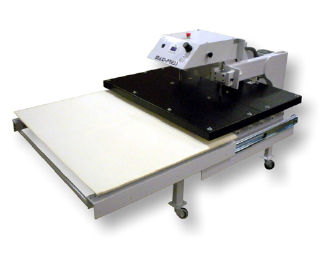
Las estampadoras de cama plana típicamente tienen una superficie de sobremesa rígida que permite transferencias a objetos sólidos tales como láminas de metal, madera, mosaicos de cerámica, felpudos, baldosas de tapetes y telas pre-cortadas. Son también algunas de las máquinas más efectivas para estampar camisetas por completo y personalizar ropa. Las estampadoras planas también requieren un tomacorriente de 240 V con una configuración de dos polos y dos vías.
Estampadora GeoKnight Maxi-Press Air (neumática).
Las estampadoras de cama plana están disponibles en los siguientes tipos:
Neumática
Las estampadoras neumáticas son más caras que las manuales. Los usuarios necesitarán un compresor de aire para hacerlas funcionar. Sin embargo, una estampadora neumática automatiza sus trabajos, permitiendo que los usuarios configuren y estampen a velocidades ultra-rápidas con solo tocar un botón. Los usuarios pueden configurar la máquina y dejarla sin atender, en lugar de estar involucrados durante todo el proceso de estampado.
Manual
Algunos usuarios prefieren las estampadoras de cama plana tradicionales que requieren mayor fuerza humana y control físico por sobre la operación real de estampado. Aunque no tienen las funciones automáticas de un modelo neumático, la mayoría de los modelos de cama plana manuales recomendados tienen funciones de medición de tiempo y presión y de auto-carga para que el estampado sea una operación semi-manual.
Estampadora de Vacío 3D (Tipo Horno)
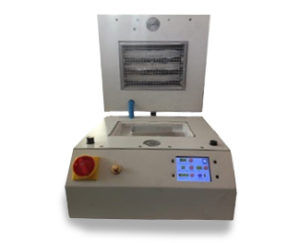
Una estampadora con una operación de vacío forzado que rotula diseños de transferencia alrededor de cubiertas de teléfonos inteligentes, platos de cerámica, marcos y otros objetos de formas irregulares. Se pueden conseguir de la marca Policrom, en tamaños de sobremesa y para taller, y requieren una película especial de transferencia, además de un accesorio específico para sublimar cada artículo. Es la máquina ideal si usted desea personalizar una gama de objetos “en blanco”.
Estampadora de vacío pequeña Policrom, que también vende películas de transferencia y ofrece asesoría para garantizar diseños de accesorios apropiados.
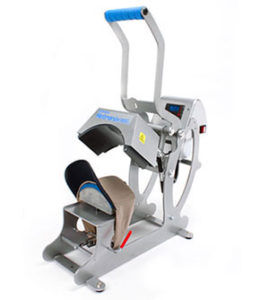
Estampadoras de Gorros de Béisbol y Tazas
Si está pensando agregar diseños a muchos gorros de béisbol y tazas, entonces hay estampadoras especializadas para ambos tipos de productos. Diseñadas para hacer una sola tarea realmente bien, son las estampadoras perfectas para aquellos usuarios que saben lo que quieren personalizar, y necesitan una determinada máquina para hacerlo.
Estampadora de gorros Hotronix
Cuando usted encuentra la estampadora ideal para combinar con su impresora de sublimación, es como el matrimonio perfecto. Solo le advertimos que no son máquinas baratas, así que antes de tomar una decisión tiene que estar completamente seguro de lo que sea más conveniente para su negocio. Le recomendamos tomarse su tiempo, hacer preguntas al distribuidor o fabricante, y observar muy detenidamente las garantías y soportes disponibles.
- Si está pensando empezar con la impresión de sublimación, vea nuestra nueva impresora de alta producción XT-640 o la simplemente brillante RT-640, o solicite una muestra gratis hoy mismo.

